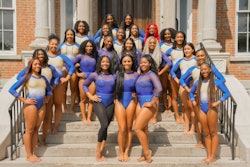The NCAA will distribute millions of dollars in March Madness money to member schools as a reward for academic performance by athletes, starting in 2019-20.
The NCAA announced Thursday that the Division I Board of Directors and NCAA Board of Governors approved the change to the revenue distribution model. The money will come from the NCAA’s multimedia rights deal for the men’s basketball tournament.
The NCAA agreed to an eight-year extension of that contract with CBS and Turner this year. The agreement now runs through 2032 and ups payment to the NCAA to about $1.1 billion per year, an increase of about $330 million annually. For the first six years of the new distribution, 75 percent of the increase in rights fees will be used to create academic distribution units similar to the units that are earned by conferences based on team performance in the NCAA Division I men’s basketball tournament.
After the first six years, the NCAA said, the percentage of growth allocated to the academic unit will equal the percentage applied to all other distributions.
“The creation of an academic distribution unit underscores the NCAA’s commitment to putting its money where its mission is – with students,” NCAA President Mark Emmert said in a statement.
Academic units will be awarded to schools that earn:
- An overall, single-year, all-sport Academic Progress Rate of 985 or higher. The APR is used to hold schools accountable for the academic progress of their student-athletes by measuring eligibility and retention of each player for each academic term.
- An overall all-sport graduation rate of 90 percent or higher.
- A federal graduation rate that is at least 13 percentage points higher than the federal graduation rate of the student body at that school.
The academic unit revenue, like athletic performance units revenue, will be paid to a conference and distributed in a manner agreed upon by its members.
University of Colorado Chancellor Philip DiStefano, who co-chaired the working group that conceived the academic unit, said the formula should allow for all schools, no matter the resources or admissions standards, to have a realistic chance of earning an academic distribution.
DiStefano said any concern that incentivizing academic performance with payments could lead to misconduct or schools steering athletes toward less strenuous course work is outweighed by the benefits.
“When you do things that are bold, you certainly take a risk,” DiStefano told the Associated Press. “I would look at it as we’re incentivizing institutions to do better and to make sure that more students are graduating.”
The amount of money in an academic unit is impossible to precisely project because it will be determined by how many schools qualify. The NCAA projects about 66 percent of the 349 Division I schools will qualify for an academic unit. Based on that, the NCAA estimates a unit could be worth $55,678 in 2019-20 and $111,356 the next year. By 2031-32, the NCAA projects each academic unit could be worth $541,368.
The Knight Commission, a watchdog group that promotes reforms in college athletics, said it applauded the NCAA’s decision to reward academic performance with revenue. The commission first called for a similar policy 15 years ago.
“It is critical to align the incentives in college sports with educational values,” said former University System of Maryland Chancellor Brit Kirwan, who is the outgoing Knight Commission chairman.
Ramogi Huma, Executive Director the National College Players Association advocacy group, said the new revenue distribution is another way for the NCAA to avoid sending money directly to athletes.
“This won’t help graduation rates because NCAA sports still turns a blind eye to its own studies showing players are forced to spend 40 hours per week or more in their sport alone,” Huma said in an email to the AP. “Instead, the players have called for a portion of new TV money to be put in an educational trust fund so players have resources and more incentives to complete their degree. Graduation rates would soar.”
Huma added the NCAA’s plan would reward schools that already have high graduation rates.
“Either way, this money was going to go to the colleges which will, in turn, waste it as they have always done,” he said.
There are no restrictions on how the money can be used, but the conferences are being asked to keep track of it and the NCAA committee on academics will monitor the usage. DiStefano said the hope is the money will go back into academics.
“This is a first,” DiStefano said. “We’ve not really incentivized with colleges and universities based upon academics. This is the first step. I think there are other steps we could certainly take.”



















